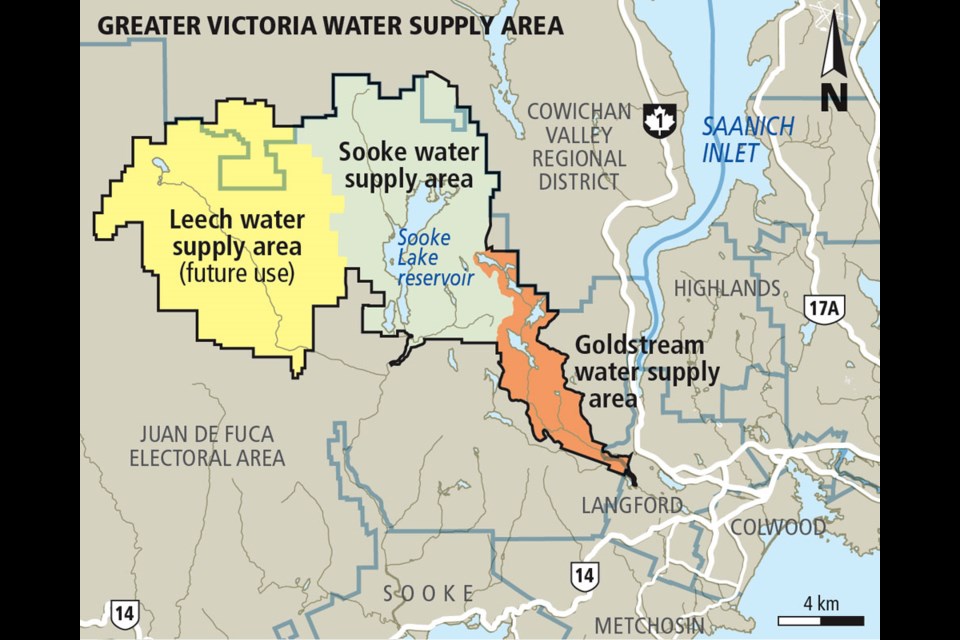Greater Victoria’s water supply would be seriously compromised if major wildfires broke out in the Sooke and Goldstream watersheds, the Capital Regional District warns.
Ash and debris from wildfires pose a significant contamination threat, said Ted Robbins, general manager of integrated water services for the CRD. “[Wildfires] could be potentially catastrophic in terms of being able to provide drinking water to residents of Greater Victoria,” Robbins said.
Southern Vancouver Island, including the Sooke and Goldstream watersheds, was under a high-danger rating Friday from the B.C. Wildfire Service. That means forest fuels are very dry and fire risk is serious.
Sooke Lake is less than 40 kilometres from the site of a 400-hectare wildfire that blazed near Lizard Lake last August.
The primary threat to the water supply area comes from ash and sediment that would contaminate drinking water, Robbins said. Because raw water quality is so high, there is no filtration system at the reservoirs.
“We’re in a unique position in that, because the CRD owns and controls all the activities in the water supply area, we have been able to avoid the need for filtration. Filtration plants tend to be in areas where there’s no control or little control over the watershed and activities there,” Robbins said.
Installing filtration would cost in the tens of millions of dollars at a minimum, he said.
As long as infrastructure was not affected by a disaster, water could still be used by residents under a boil-water advisory. There may be an unusual flavour or odour, but boiling water would kill bacteria, Robbins said.
The Sooke dam is expected to survive major fires and while powerlines may be affected, there is standby power available to continue operating the dam, Robbins said. The disinfection plant could be vulnerable, but staff clear trees and take other precautions to create a buffer around the facility.
The CRD is monitoring the potential impacts of climate change, including projections of harsher droughts and more wildfires, Robbins said.
Twice-daily aerial patrols are set to begin next week. Ground patrols also check for fires.
If there’s a major wildfire, the CRD has a response agreement with the B.C. Wildfire Service. The CRD also has 60 staff members for initial wildfire attacks.
“These are staff who have other day jobs, but are trained in initial attack for wildfires,” Robbins said. “If we have a fire break out for the watershed, our staff and equipment would provide initial response and we’d be calling on the province for additional support.”
Sidney Coun. Mervyn Lougher-Goodey, who chairs the CRD’s Regional Water Supply Commission, said fire threat is the main reason he argued for limiting public access to the Leech Water Supply Area, which is intended for future use.
The commission is drafting a new bylaw, which will go before the CRD board in the coming weeks, Lougher-Goodey said.
Public access is already limited in the Sooke and Goldstream watersheds. “My biggest fear in the watersheds is fire. And the best way to [prevent] that is to keep humans out,” he said.
Others have argued that the watershed should be open to the public for recreation. In April, Victoria Coun. Ben Isitt argued for a permit system, saying Leech won’t likely be needed as a water source for at least 27 years.
Mike Hicks, Juan de Fuca electoral area director, said the public should have access, but it could be restricted during fire season.
The CRD purchased lands in the Leech River watershed for $62 million in 2007 and 2010, to supplement the existing water supply in Sooke Lake Reservoir.
Chris Duffy, head of operations for Emergency Management B.C., said no part of the province is immune to wildfire. “With the right mix of prolonged hot and dry weather, and winds from the right direction to fan the flames, a wildfire could certainly grow into a major emergency in any jurisdiction,” he said. “It is important to understand, however, when making comparisons to Fort McMurray, that we cannot draw linear parallels because of the difference in geography, topography, the forest fuel type.”



